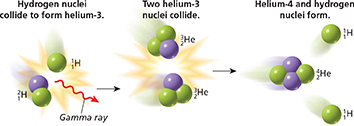Figure 2 Nuclear fusion within the sun's central region converts mass into energy. The green particles in the diagram are protons and the purple particles are neutrons.?
Interpreting Diagrams What new isotope is produced by this fusion reaction?
 dd
ddScottish geologist Charles Lyell disagreed. Lyell argued that geological processes on Earth had taken hundreds of millions of years. Therefore, Earth and the sun must be far older than other scientists had thought. Evidence from various branches of science eventually led scientists to conclude that the sun is actually about 4.6 billion years old.
How could the sun produce energy for so long? Clearly, the hypotheses about chemical reactions and the sun shrinking were incorrect, as they could not account for the actual age of the sun. It wasn't until the early 1900s that scientists discovered the real source of the sun's energy—nuclear fusion in its central region. Here the temperature and pressure are high enough for fusion to take place. In the process of fusion, as shown in Figure 2, less massive nuclei combine into more massive nuclei, releasing enormous amounts of energy.  The sun's energy is produced in its central region by the fusion of hydrogen nuclei into helium nuclei.
The sun's energy is produced in its central region by the fusion of hydrogen nuclei into helium nuclei.
Forces in Balance
The fossil record of life on Earth shows that the sun has been a fairly stable energy source for billions of years. For the sun to be stable, inward and outward forces within the sun must be in equilibrium. The forces are balanced so that temperature, pressure, and density at any depth remain fairly constant over time.
The energy from nuclear fusion in the center of the sun causes ions to move faster, exerting an outward thermal pressure. At the same time, gravity pulls the gas inward, as shown in Figure 3.  The sun remains stable because the inward pull of gravity balances the outward push of thermal pressure from nuclear fusion. The sun will remain stable as long as there is a steady energy source within it. Astronomers estimate that the sun will remain stable for another 5 billion years.
The sun remains stable because the inward pull of gravity balances the outward push of thermal pressure from nuclear fusion. The sun will remain stable as long as there is a steady energy source within it. Astronomers estimate that the sun will remain stable for another 5 billion years.

How long will the sun remain stable?
Figure 3 Gravity and the outward thermal pressure from nuclear fusion are balanced throughout the sun. Both the force of gravity and the pressure are greater deep within the sun than near the sun's surface.
Predicting What would happen to the sun if it began to run out of fuel?





